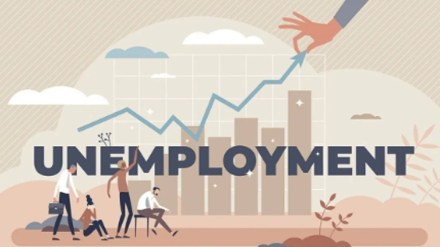– By Pratik Modi
The current election debate highlights the perennial issue of unemployment in the country. The CSDS-Lokniti pre-poll survey asked respondents about their top voting considerations, and unemployment dominated the list. A consistently high unemployment rate signifies financial distress with adverse social and political consequences. Unemployed individuals continue to consume resources without positively contributing to economic growth, leading to a proportional decline in economic progress. This is particularly concerning because capitalism relies on continuous consumption and productivity growth.
Types of Unemployment
Unemployment can be categorized into different forms. Frictional unemployment is the natural period of job-seeking that occurs when people leave one position in search of a better opportunity. Typically, a 3-4% rate is considered normal for a healthy economy. Structural unemployment occurs when workers’ skills or income expectations do not align with available jobs, often due to technological shifts or changing economic conditions. It is deeply rooted in shifts that redefine industries and create mismatches between the skills needed and those available. Cyclical unemployment is linked to economic downturns. It arises when new workers entering the workforce struggle to find jobs due to lower demand during economic contractions. And institutional unemployment caused by socio-economic factors like minimum wage laws or restrictive job licensing that unintentionally limit employment opportunities.
Creative Destruction and Keynesian Economics
While each category requires unique approaches, structural unemployment presents a particular challenge because it stems from fundamental shifts in technology and the economy. Austrian economist Joseph Schumpeter’s concept of “creative destruction” explains how technological progress eliminates old industries and jobs while creating new ones. Despite this, the pace of job creation often lags behind technological advancements, leaving many workers unemployed or struggling to reskill. Schumpeter argued that this cycle of destruction and renewal is intrinsic to capitalism and vital for long-term growth, though it also leads to considerable dislocation and hardship. John Maynard Keynes, on the other hand, focused on cyclical unemployment. In “The General Theory of Employment, Interest and Money,” Keynes argued that during economic downturns, aggregate demand decreases, leading to layoffs and unemployment. He advocated for government intervention through fiscal and monetary policies to stimulate demand, thereby reducing unemployment. Keynesian economics continues to influence modern welfare policies, promoting public works programs, unemployment benefits, and direct government employment during economic contractions.
The Role of the Welfare State, Challenges, and Limitations
Governments can help bridge unemployment gaps by offering skill training, education, and incentives to develop a workforce that can thrive in emerging industries. However, even with comprehensive upskilling programs, some unemployment is inevitable due to the skills mismatch and the displacement caused by innovation. In this context, welfare programs become a necessary tool for supporting individuals during these transitions.
The welfare state plays a critical role in cushioning the effects of technological progress and cyclical downturns by providing a safety net for those affected. Welfare programs like unemployment benefits, retraining grants, and health insurance ensure that displaced workers can maintain a basic standard of living while they adapt. These measures help mitigate the immediate economic and social impacts of job loss, preventing widespread poverty and instability. Moreover, welfare policies also aim to reduce long-term unemployment by fostering continuous learning and adaptability. Programs designed to encourage education, skill acquisition, and mobility can help workers transition into emerging industries. Incentives for businesses to provide on-the-job training or hire long-term unemployed individuals can also help reintegrate workers into the labor force.
Despite these programs, structural unemployment remains a persistent problem because technological progress often outpaces the capacity of workers to reskill. A growing emphasis on automation and artificial intelligence has transformed traditional sectors like manufacturing and retail, requiring new digital and analytical skills that many older workers lack. Additionally, geographical imbalances may exacerbate the problem, as job opportunities tend to cluster around urban areas with vibrant technology hubs. Cyclical unemployment also poses challenges because welfare programs can only alleviate its effects temporarily. If aggregate demand remains low, Keynesian measures like infrastructure spending or monetary easing can only do so much. The private sector’s reluctance to invest in uncertain economic environments often slows recovery.
To sum up, unemployment is an inevitable part of the capitalist economy due to the continuous changes in industries and technology. Schumpeter’s concept of creative destruction and Keynes’s insights into cyclical unemployment explain why modern economies face structural shifts that cannot be fully mitigated. However, the welfare state plays an indispensable role in providing stability by offering temporary relief to those affected and helping them transition into new opportunities.
Given the CSDS-Lokniti survey identifying unemployment as the top voter concern, the implications for both voters and political parties are crucial. For voters, this means making informed decisions by supporting candidates who prioritize comprehensive solutions to address long-term unemployment. For the government, this requires prioritizing workforce development initiatives that tackle structural unemployment while fostering rapid economic growth. Ultimately, the goal should be to foster a flexible, skilled workforce that can thrive in emerging industries while ensuring that the core promise of economic opportunity remains accessible to all.
(Pratik Modi is the Dean – School of Management, at BML Munjal University.)
(Disclaimer: Views expressed are personal and do not reflect the official position or policy of Financial Express Online. Reproducing this content without permission is prohibited.)
